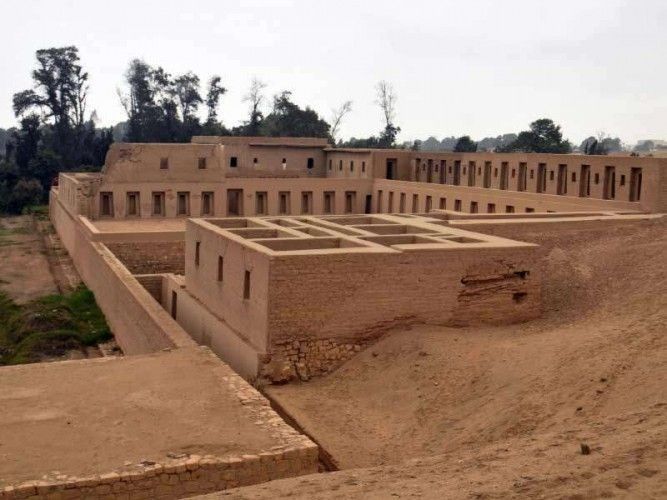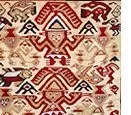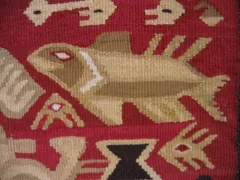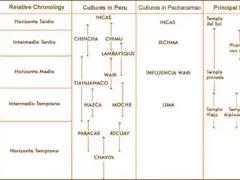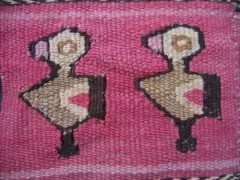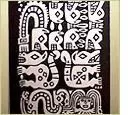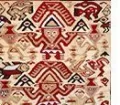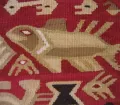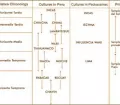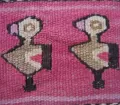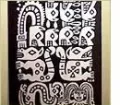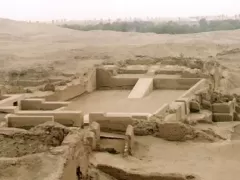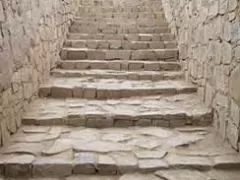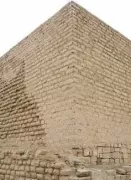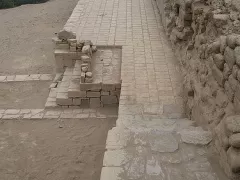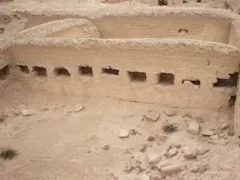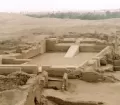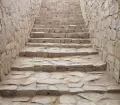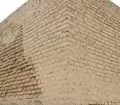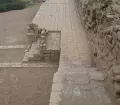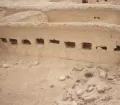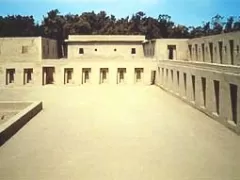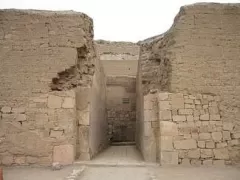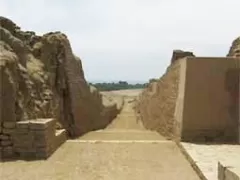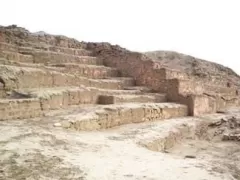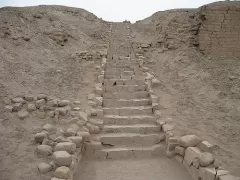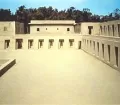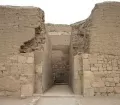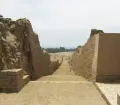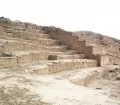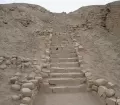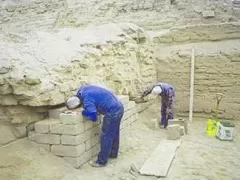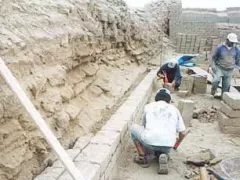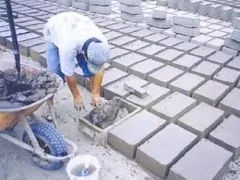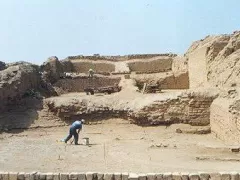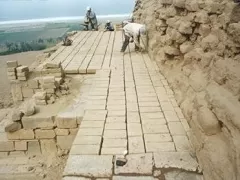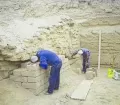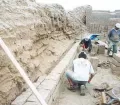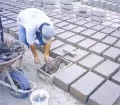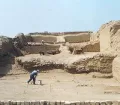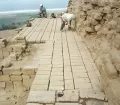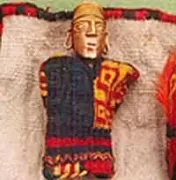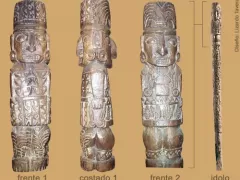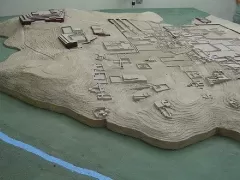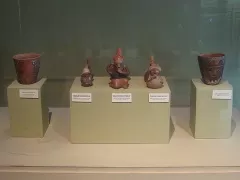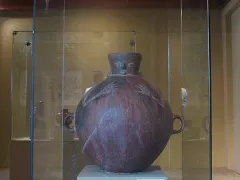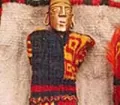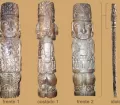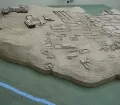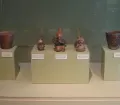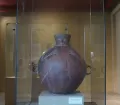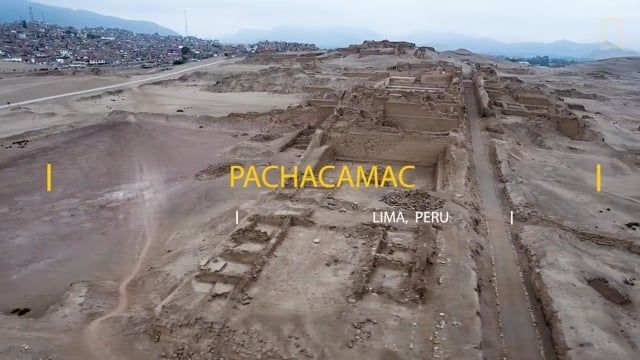The history of Lima and the population of the surrounding area did not only begin with the foundation of the colonial city by Francisco Pizarro in 1535. Actually, the area of today’s city and province of Lima was inhabited many thousands of years before that by numerous different, highly advanced pre-Hispanic cultures that left us impressive settlements and constructions.
One of these is the ancient city of Pachacamac. Located just about 35 km (22 miles) south-east of Lima’s city center, the enormous site with its great pyramidal temples, buildings, old roads, remains of frescoes decorating the adobe walls and other interesting archaeological structures that were erected over a time period of over 1000 years by different cultures gives visitors am astonishing insight into the society and lifestyle of people living in the area.
The enormous site of which several temples, buildings and a part of the Inca road system have already been excavated while other structures wait to be discovered, was the most important administrative and religious center of indigenous people at the Peruvian coast. It was a major pilgrimage destination in the coastal region and attracted worshippers from all over the Inca Empire; at least until the Spanish conquest.
History of the ancient city of Pachacamac – Lima Culture (~200 AD)
Around 200 AD, the Lima Culture occupied the area of today’s Pachacamac and started to build the first structures of what soon would become a large religious center. They used materials and construction techniques that were very complex at the time. Stone walls served as a base for remarkable structures made of "adobitos" (small adobe bricks), still evident at the Conjunto de Adobitos, the Templo de Urpiwachak and the Templo Viejo.
The ceremonial center was dedicated to Pacha Kamaq (Pachacamac), the most important god at the Peruvian coast in pre-Hispanic times. Pacha Kamaq – which translates "The one who animates the world" - was a feared and powerful deity that not only was considered the architect of the world and creator of all its creatures, but also the god of fire and earthquakes. The adoration of Pacha Kamaq and the influence of the center during the reign of the Lima Culture however was limited to the immediate surroundings.
History of the ancient city of Pachacamac – Wari Culture (~650 AD)
With the Wari Culture (around 650 AD) in Pachacamac, the city flourished and expanded its importance and influence on outer regions. The Wari used Pachacamac not only as ceremonial center but also as administrative center for their businesses in the coastal Andes region. They only built a few new structures such as the Templo Pachacamac, most commonly known as Templo Pintado (the painted temple) and rather changed, rebuild and extended existing structures.
Many beautiful ceramics and textiles as well as an extensive cemetery from that time were unearthed. After the decline of the Wari, the city continued to grow and expand its power and influence. The adoration of the god Pacha Kamaq increased.
History of the ancient city of Pachacamac – Ichma Culture (~1200 AD)
Around 1200 AD, the Ichma Culture occupied Pachacamac. During their time, the city and religious center got even more magnificent. The Templo Pintado was fortified and another 15 main temples and "stepped pyramids" with ramps, storage facilities and patios were built using adobe bricks and mortar. They were plastered but not painted. Two principal streets and many smaller roads connected the temples, administrative buildings and dwellings.
The power and influence of the city and religion was so great that there was no way around Pachacamac in the coastal region.
History of the ancient city of Pachacamac – the Incas (~1450 AD)
By the time the Incas arrived at the central coastal area of Peru and occupied Pachacamac (around 1450 AD) the city was so powerful with a popular and extremely strong adoration of Pacha Kamaq that the Incas feared to tamper with the religious beliefs of the population. Even though completely unusual for them, they allowed the god Pacha Kamaq to co-exist along their own sun god Inti.
The existing structures, temples and other buildings of the city however were modified, expanded and rebuilt to the needs of the Incas. They erected some remarkable new pyramids and temples, among them the Templo del Sol (the Temple of the Sun) and the Acllahuasi (the House of the chosen women), also known as Mamacona.
The Sun Temple was constructed on a hill overlooking the Pacific Ocean and dedicated to their sun god, Inti. The amazing temple is built with stones and adobe blocks. The walls of the temple were decorated with red and yellow paint.
The Acllahuasi was a building only for young, chosen maidens, probably comparable to a convent. The principal purpose of these women was to serve the sun god Inti, the Inca priests and nobles, to prepare ceremonies, to be given to or married to great Inca warriors or aristocrats, or to be sacrificed. It was a privilege to belong to the chosen ones.
Next to the Templo el Sol and the Acllahuasi the Incas built other astonishing structures such as the Plaza de los Perigrinos and the Palacio de Taurichumbi.
Shortly before the Spaniards arrived in Peru, Pachacamac and the adoration fof the powerful god Pacha Kamaq was at its height.
History of the ancient city of Pachacamac – the Spaniards (1532 AD)
Heavily divided by a civil war and weakened by civilization diseases (especially smallpox, that swept to Peru from conquered Panama), the Spanish conquerors under the leadership of Francisco Pizarro and his brothers easily captured the Inca ruler Atahualpa in 1532, defeating his army and ending the Inca rule in most parts of Peru.
When Pizarro learnt about the powerful and influential city of Pachacamac, he immediately sent an expedition there, subdued the population, plundered the site and destroyed all religious objects. The cult, adoration and power that for hundreds of years radiated from Pachacamac was wiped out and the great complex of Pachacamac forgotten.
Pachacamac in the 19th and 20th century
In the 19th century Pachacamac was rediscovered and archaeologists such as Adolph Bandelier, Ernst Middendorf and Max Uhle carried out the first investigations and excavations. But their publications about the enormous archaeological and historical wealth and value of the site and the Lima region weren't recognized.
In 1939, Dr. Alberto Giesecke started to investigate and restore the Templo Pintado. He found Pacha Kamaq’s main idol and a few other unique pieces. In the following decades many recognized archaeologist, among them Dr. Julio Tello, William Strong, John Corbett and Dr. Arthur Jimenez Borja, researched, partly restored and reconstructed the Acllahuasi, the Templo del Sol and the Conjunto de Adobitos.
Pachacamac ruins today
More or less since the 1990s, many foundations and cultural institutions finance further investigations and restoration projects to save this vast ancient religious and administrative center with its valuable patrimony for future generations.
Extensive research and excavations, especially in the last decade, revealed amazing findings which help to understand the history of Pachacamac and prove its significance. While today quite a few temples, pyramids, buildings, roads, a part of the Inca road system, thousands of mummies and many unique artifacts already have been excavated, other treasures are still unearthed; so there is a lot more to be discovered.
On-site museum at the Pachacamac ruins
The modern museum, at the entrance to the Pachacamac ruins, explains the history and importance of the ancient city of Pachacamac and the surrounding area. It displays artifacts discovered at Pachacamac among them astonishing ceramics, beautiful textiles and ceremonial pieces and gives visitors a great insight into the development and accomplishments of different pre-Hispanic cultures and societies over a time of over 1000 years.
How to get to Pachacamac ruins
Countless tour operators offer usually half-day tours to the Pachacamac ruins from Lima daily.
If you prefer to visit the archaeological site at your own pace or on a budget, it’s easy to get there by car or taxi and doable by bus as well.
A taxi driver will know the way. So, no worries there. Agree on a price before you set off; one way from Miraflores to Pachacamac should be about S/ 60, a return trip more or less S/ 100, but expect about S/ 20 to S/ 25 per hour for waiting time. It might be a wise decision to either let the driver wait for you at the Pachacamac ruins or arrange a pickup time.
If you drive with your own or rented car, get onto the PanAmerica Sur highway and take the Lurin exit. You will automatically cross the highway and end up on the other side. Turn right onto the Antigua PanAmerica and follow the road for about 1 km (a good half mile). The entrance will be on your right side.
If you want to go by bus, take one that goes to Pachacamac. When you are in the city center they leave from Av. Abancay, when in other districts, first get to the PanAmerica Sur (when in Miraflores for example go to Av. Benavides and take a combi marked “S” that will run along Av. Benavides. Get off shortly after the Ricardo Palma University at the Puente Benavides. Walk down the stairs and take the combi that goes to Pachacamac. Ask the driver or better the guy that collects the money to let you out at the Pachacamac ruins.
Useful Information for visiting the ancient city of Pachacamac
- Wear comfortable cloth and proper shoes
- Don't forget sun protection (sun glasses, cap and sun cream) especially in the summer
- Take drinking water with you
- Use the bathrooms at the entrance, because there aren't any inside the area
- You may not bring food inside the archaeological zone
- If you are not familiar with Peru’s ancient cultures, invest in an official guide at the entrance.
- Enjoy the amazing view over the Pacific Ocean (best seen from the Temple of the Sun).
Address: Antigua Panamericana Sur km 31.5, Lurin, Lima
Opening Hours: Tuesday to Saturday from 09.00 am to 05.00 pm, Sunday from 09.00 am to 04.00 pm (ticket sale only until 45 minutes prior to closing time)
Entrance Fees: Adults S/ 15, students S/ 5, children (under 12 years) S/ 1, senior citizens and people with disabilities S/ 7.50
Guide: S/ 25 per group of max. 20 people; guided tours take about an hour. To ensure an (English speaking) guide is available during your visit, best make an appointment under reservaspachacamac@cultura.gob.pe
Shop: sells a few books and postcards, as well as pieces made by a local women's collective.
Restaurant: There’s a small on-site restaurant / café that sells refreshments and snacks.


